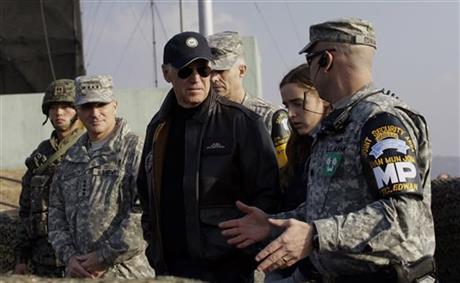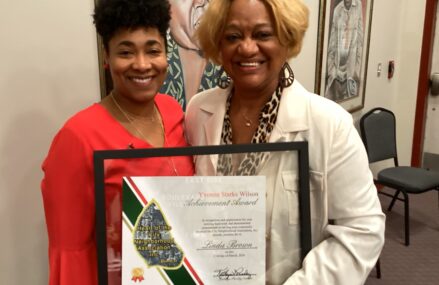
By JOSH LEDERMAN
FILE – This Dec. 7, 2013 file photo shows Vice President Joe Biden, center, is briefed by Lt. Col. Daniel Edwan, the commander of the JSA Security Battalion from Observation Post Ouellette during his tour of the Demilitarized Zone (DMZ), near the border village of Panmunjom, which has separated the two Koreas since the Korean War, South Korea. As Biden left for Asia last week on a mission to show the U.S. is determined to be a major Pacific player, a brewing regional crisis over disputed airspace seemed certain to derail his message by hogging all the attention. In the end, it was quite the opposite. Shuttling from one Asian capital to the next, Biden found himself at the center of the dispute, playing mediator for China and its neighbors, and acting as emissary between Japan and South Korea in a separate feud between the two U.S. allies. The intense diplomacy on issues far removed from Washington reinforced the degree to which leaders in Asia still look to America to try to solve problems when no one else can. (AP Photo/Lee Jin-man, File-Pool)
Joe Biden
U.S. Vice President Joe Biden, front left, shakes hands with South Korean and U.S. soldiers during a tour of the Demilitarized Zone (DMZ) at the border village of Panmunjom, which has separated the two Koreas since the Korean War, South Korea, Saturday, Dec. 7, 2013. Biden praised North Korea’s release of an elderly U.S. tourist Saturday, but admonished the North for detaining him in the first place and called for another detained American to be swiftly released. (AP Photo/Lee Jin-man, Pool)
Joe Biden, Xi Jinping
Chinese President Xi Jinping, right, shakes hands with U.S Vice President Joe Biden, left, as they pose for photos at the Great Hall of the People in Beijing, China, Wednesday, Dec. 4, 2013. (AP Photo/Lintao Zhang, Pool)
Joe Biden, Shinzo Abe
U.S. Vice President Joe Biden, left, is welcomed by Japanese Prime Minister Shinzo Abe prior to their talks at Abe’s official residence in Tokyo Tuesday, Dec. 3, 2013. Biden, who is on the first leg of his three-nation Asian tour, met Abe, whose government is pressing the U.S. to more actively take Japan’s side in an escalating dispute over China’s new air defense zone above a set of contested islands in the East China Sea. (AP Photo/Toru Yamanaka, Pool)
Joe Biden
South Korean soldiers salute U.S. Vice President Joe Biden, right, at Observation Post Ouellette in the Demilitarized Zone (DMZ), near the border village of Panmunjom, which has separated the two Koreas since the Korean War, South Korea, Saturday, Dec. 7, 2013. (AP Photo/Lee Jin-man, Pool)
South Korea China
A map of South Korea and its region shows the Air Defense Identification Zone (ADIZ) set up by three east Asian nations at Defense Ministry in Seoul, South Korea, Sunday, Dec. 8, 2013. South Korea on Sunday announced expansion of its air defense zone following China’s move to establish a similar zone that has been criticized by Beijing’s neighbors. Green line signifies ADIZ set up by Japan as blue dotted line is ADIZ set up by South Korea before they unveiled on Sunday an expanded new ADIZ which is shown in red line. Gray dotted line in the bottom is ADIZ set up by China. (AP Photo/Lee Jin-man)
South Korea China
South Korean Defense Ministry spokesman Kim Min-seok speaks during a press conference on the country’s new defense zone at Defense Ministry in Seoul, South Korea, Sunday, Dec. 8, 2013. South Korea has announced its expanded air defense zone amid a regional row over China’s newly declared air identification zone. (AP Photo/Lee Jin-man)
Prev 1 of 7 Next
SEOUL, South Korea (AP) — As Vice President Joe Biden left for Asia on a mission to reinforce America’s determination to be a major Pacific player, a regional crisis over disputed airspace threatened to drown out his message.
In the end, it was quite the opposite.
From one capital to the next, Biden found himself at the center of the dispute, playing referee for China and its neighbors. He also acted as emissary between Japan and South Korea in a separate feud between the U.S. allies.
The intense diplomacy on issues far removed from Washington made clear the degree to which leaders in Asia still look to America to try to solve problems when it seems like no one else can.
Biden tried repeatedly to head off the notion that the Obama administration’s push to “rebalance” its foreign policy toward a fast-growing Asia had petered out.
“The United States never says anything it does not do,” Biden said in Seoul.
Even if the White House has found it difficult to keep one foot in Asia amid crises in the Mideast, there was little doubt that Asian powers see the U.S. playing a leading role, decades after wars in Japan, Vietnam and Korea brought tens of thousands of U.S. troops to the region.
Each country wanted something specific from Biden.
Japan and South Korea wanted the U.S. to stand firm against China’s unilateral declaration of an air defense zone over disputed islands in the East China Sea. Japan, in particular, wanted assurances the U.S. wouldn’t acquiesce by advising U.S. commercial pilots to comply with the zone.
China wanted the vice president to mimic specific phrasing about pursuing a “new model of major-country relations” that’s become an officially sanctioned mantra for Chinese officials. He did, often.
South Korea wanted Biden to help choreograph an exchange of public gestures between Seoul and Tokyo to alleviate resentments over Japanese colonialism that have reached a fever pitch.
As if to demonstrate how closely Asia is watching the U.S., North Korea released an elderly U.S. tourist detained since October — hours before Biden was set to visit the Demilitarized Zone. Security experts speculated the move probably was intended to deny Biden the chance to cast a spotlight on the U.S. list of indictments against the North.
Biden just wanted everyone to cool it.
He quietly urged Beijing to refrain from enforcing the airspace zone, hoping to give the government a way out, rather than insisting that it formally rescind the zone.
He wanted Tokyo to drop its objections to a major trade deal.
He wanted Seoul to avoid sudden movements and consult with its neighbors before expanding its own air defense zone to send a stern message to China. South Korea on Sunday said it was expanding its zone, which overlaps with China’s, and the State Department said it supported the step.
It’s an open question whether Biden achieved the desired results, and all the issues he raised will require significant follow-up with the leaders he saw in Asia.
In more than one instance, Biden’s outreach seemed to brush up against the reality that some American diplomatic pursuits in Asia are working at cross purposes.
Biden said the U.S. commitment to its allies is unwavering. But the U.S. is pursuing closer economic ties with China, whose growth and increasing assertiveness have the region on edge.
Michael Green, a White House adviser on Asia in the George W. Bush administration, said by embracing Chinese diplomatic language about a new model of major-country relations, Biden sent an implicit message that America’s bonds with allies like Japan and South Korea are becoming less important.
“That was not the intended message, I am sure, but that is how it is being read by worried allied capitals,” Green said.
U.S. officials have said they don’t want to be the mediator for regional disputes in Asia. In fact, the U.S. has tried to avoid taking sides on the question of sovereignty of the islands in the East China Sea — a major point of contention for China and its neighbors.
But it’s difficult to be “all in,” as the White House has described its Asia policy, and also stay out.
Asian nations looking to the U.S. for leadership and conflict resolution may be less inclined to welcome America’s presence in the region if they perceive the U.S. only wants to engage when it has something to gain.
___
EDITOR’S NOTE — Josh Lederman covers Vice President Joe Biden and the White House for The Associated Press.
___
Josh Lederman can be reached at http://twitter.com/joshledermanAP
An AP News Analysis


